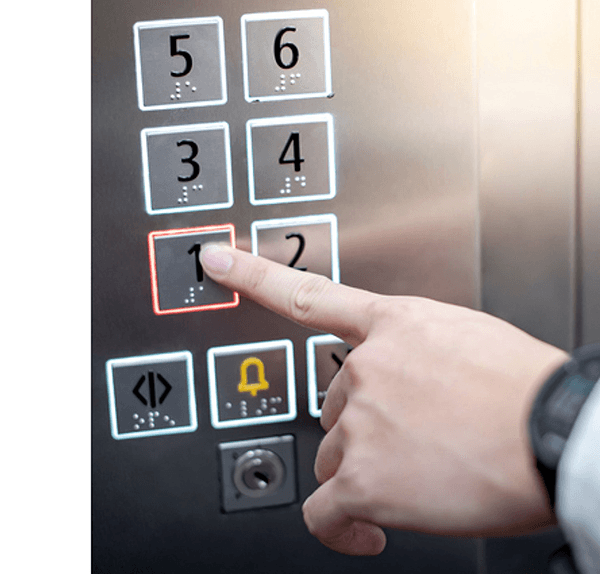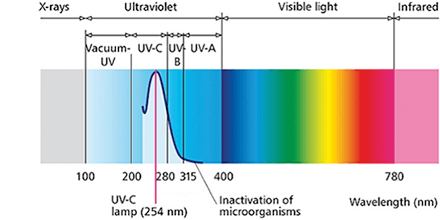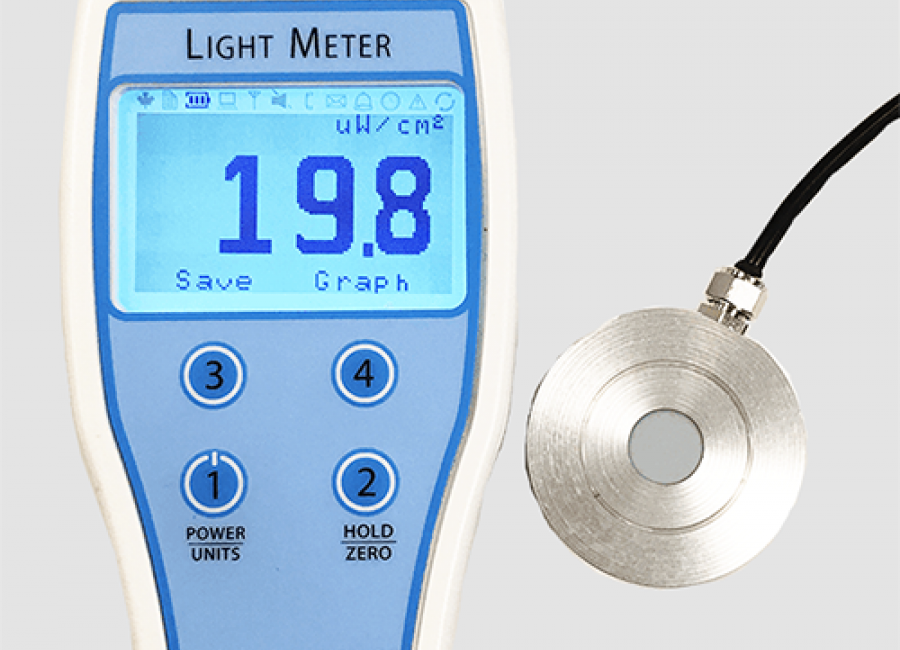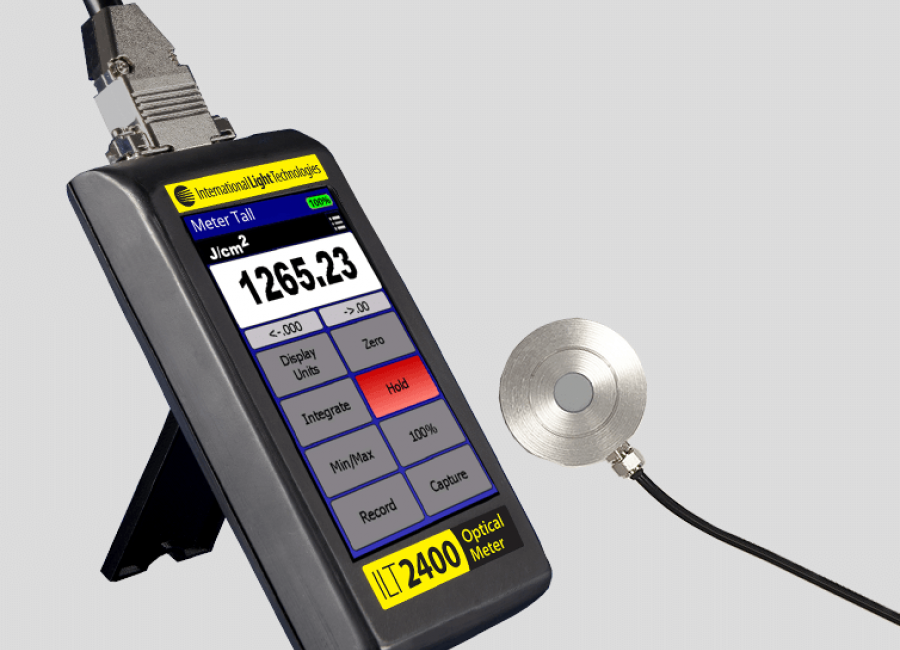
In the age of covid, businesses, building owners, facilities managers, and the like are scrambling to find ways to disinfect surfaces that people come into frequent contact with. In the US alone, millions of elevators transport billions of passengers each year. From urban high rises carrying cabs filled with workers, to hospitals, universities, apartment buildings, airports and more, elevators ferry some 20,000 passengers each day to their vertical destinations.
In addition to the numerous touch points found in elevators, from handrails to call buttons, elevators are small, enclosed spaces where germs can easily lurk on surfaces and in the air. Frequent cleaning of elevator cabs is time consuming and costly. With new social distancing measures that limit the number of riders in an elevator, taking elevators offline for cleaning would further delay people getting where they need to be.
Enter UV light disinfection. UV light has long been used to disinfect air, liquid and surfaces. With the shortage of PPE in hospitals and medical facilities, UV light found a new application protecting healthcare workers by disinfecting their masks and gowns so they could be safely re-used.
How UV Light Disinfects
Known as ultraviolet germicidal irradiation or UV disinfection, UV light effects germs at the molecular level. Short-wave UVC light penetrates microbes and interferes with their ability to reproduce, rendering them ‘inactive’. Every microbe has a specific deactiviation point. The deactiviation point is dependent upon the amount of light the germ is exposed to, the wavelength of light, and the duration of exposure. In light measurement, this is referred to as the dose or fluence, and is measured in J/cm2.
Light in the UVC part of the spectrum, which is from 100 - 280 nm, does not occur in nature as our atmosphere filters out this light from reaching earth. There are many man-made light sources that will generate UVC light. Some of those sources include:

- Low pressure mercury lamps
- Low pressure amalgam lamps
- Medium pressure mercury lamps
- Excimer lamps
- Light emitting diodes (LEDs)
- Xenon lamps
Each of these light sources will have a different 'peak wavelength' so is important to know the specifications of the source you are using in order to get an appropriate measurement system to validate it.
Benefits of UV Disinfection
In addition to being effective at killing germs, there are several other advantages to using UV light for anti-microbial applications. First, UV light disinfection can be done with little or no human intervention. Most UV light disinfection systems are either permanently mounted fixtures, or a robotic apparatus that can be deployed by remote control. In an elevator, occupancy sensors can detect whether or not people are present inside the cabin, and turn the disinfecting lights on when the cab is empty. This can allow for cleaning any time the elevator is not in use. Unlike fogs or ozone, UV light does not need time for the air to clear of fumes or odors in order for the area to be safe for people. Neither does it leave a residue or harsh smell like with chemical cleaners. Once the light is off, the hazard is gone. In short, UV light can provide an effective, efficient disinfection process free from after-effects.
Like with all things, UV disinfection does have some drawbacks that users should be aware of. First, UV light is extremely hazardous to humans and cannot be performed in any instance where a person might be directly exposed without protective equipment. UVC exposure can at the least cause skin and eye irritations, and at the worst, burns, cancer and blindness. Disinfection of a surface requires a clear line of sight to the UV source, so areas that are shadowed will not be treated. UVC light can also be damaging to inanimate materials and surfaces. Over a long period of time UV light can cause some materials to crack, peel, discolor, or otherwise degenerate.
All UVC systems will likely require some kind of maintenance. Reflectors may need cleaning and lamps will need eventual replacing. UVC systems can be a costly investment but can pay back quickly by offsetting the need for manual cleaning.
Why is Light Measurement of UV Systems Necessary?

When relying on a disinfection system to prevent the spread of diseases, it’s important to check that the system is operating to its specifications. Like any thing else, normal wear and tear can impact the performance of a disinfection system. Dirt and grime can build up on lamps and reflectors causing less light to reach surfaces. Lamps can get knocked out of alignment causing shadowed areas that are not fully irradiated. And lamp aging can result in both light loss and spectrum shift - meaning neither the right amount of light nor the right wavelength of light is reaching its target. Verifying not only that the system is performing, but at what level, can help users quickly and easily identify and address problems.
Lastly many UV systems operate in enclosed environments where visually watching the process is not safe or easily possible. Even if visually monitored, UV light is invisible to the naked eye. You cannot simply “look” at the light source and know that it is working properly. Light measurement devices allow users to quickly, easily, and safely validate the performance of their system. A good light measurement system will:
- Confirm the amount of light reaching a surface
- Calculate the dose in Joules or J/cm
- Graph the output over time
- Validate the Min/Max and Average Irradiance (mW/cm2)
- Save the results for exporting to your PC for additional analysis
Good light measurement systems will further simplify the process through features such as auto-ranging. This feature automatically detects the input range so users don’t have to manually dial it in. Meters with simple user interfaces with only a few buttons will let them easily toggle between readings. LCD display screens will let users see in graphical terms the changes in light uniformity over time. Meters that carry an ISO/IEC 17025:2017 accredited and NIST traceable calibration certificate provide the added assurance that readings are accurate and reliable.
Key Takeaways
Ultraviolet Germicidal Irradiation is an efficient and effective means of disinfection. There are many UV disinfection systems on the market designed specifically for elevators. Many elevator manufacturers are beginning to incorporate this capability into their new systems. A good light measurement tool is an excellent compliment to any UV disinfection system. While you should be able to trust the manufacturers specifications, it is always good practice to verify them.
ILT offers several UVC light measurement systems to meet a variety of lamp specifications and budgets. These products can be seen below in the related section.



